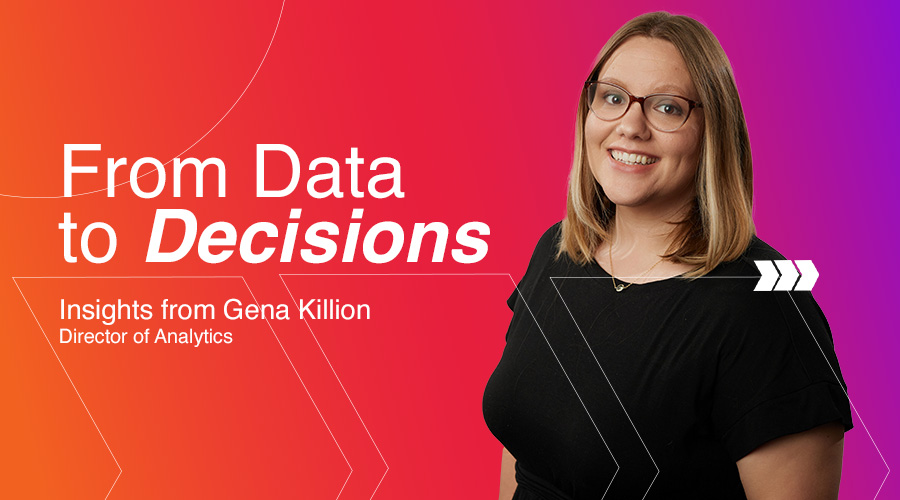Simantel recently hosted 50 marketing professionals from 21 AMIN agencies in Peoria for the Data Distillery, a conference about the evolving role of data in our industry. Individuals representing a variety of functional areas across agencies — from data analysts to strategists to agency leaders — heard from keynote speakers and participated in sessions that sparked conversations about balancing data and creativity. While there was no shortage of valuable takeaways, three ideas really caught our attention as ones that will shape the future of marketing.
#1: The Power of Data is in the Story
We’re among the first to say that data is great. However, it can be overwhelming when it’s presented as a barrage of charts and spreadsheets. Data becomes most powerful when it’s used to tell a story. Clients, audiences and even internal teams respond far better to a narrative they can connect with emotionally.
The trick is to take those numbers and transform them into something relatable and meaningful. This means not just presenting the data but interpreting it in a way that highlights its significance. This idea was reinforced by business leaders who were part of a client panel about data, tools and what their organizations really need. Bottom line: less “marketing speak” (as in, they don’t want to hear things about “big data” or “holistic views”). Instead, keep the explanations simple. Replace jargon with everyday words and focus on what matters. Frame the data in terms of how it impacts your audience. For example, “This trend shows that customers are looking for quicker solutions, which means we need to focus on offering more instant support options.”
By weaving data into a story that sparks action, we can shine a light on the insights hidden within the numbers. This storytelling approach allows us to illustrate trends in a way that captivates and motivates stakeholders. Ultimately, the goal is to empower decision-makers with insights that lead to informed choices, foster collaboration and drive progress. In our world, data isn’t just about the numbers; it’s about the stories those numbers tell and the impact they can create.
#2: The Data Pool is Deep
The data we use to drive insights is no longer limited to just marketing inputs. It’s now a blend of marketing, behavioral, operational and transactional data. In fact, according to the Salesforce State of Marketing Report, 88% of marketers are using customer service data and 82% are using transactional data to create a better picture of their customers. These combined sources give us richer insights, but they also require a more nuanced approach to understanding and applying the information.
Think about it: we’re not just analyzing clicks and impressions anymore. Now, we’re looking at how customers behave, what they do when they interact with our brand, what operational hurdles we might face, and how all of these factors influence purchases or conversions. It’s like having a 360-degree view of everything.
Related Content: 2024 B2B Marketing Trend Predictions: First-Party Data
However, as exciting as this sounds, it’s also a lot to manage. Marketers are being asked to become fluent in data, which means we’re now part creatives, part analysts and all about strategy. We need to understand how to interpret data, pull actionable insights and connect those insights back to real business objectives. By blending marketing data with behavioral cues, we can deliver experiences that are far more personalized, creating a deeper connection with customers. Operational and transactional data, on the other hand, help us see what’s working and where we can fine-tune processes to better meet customer needs.
Ultimately, blending these different data sources and staying ahead of the rapid pace of change is how we’ll better understand our customers, deliver more relevant experiences and continue to push our brands forward.
#3: Technology is Evolving and AI Is Here to Stay
One of the biggest challenges we face is the speed of change. Technology is evolving faster than ever and, as marketers, we’re expected to keep up. Tools that were revolutionary a few years ago are quickly being replaced by more advanced options, like AI and machine learning. These technologies are becoming essential for marketers to uncover insights we wouldn’t be able to find manually. It’s an exciting time, but it also means we have to be on our toes constantly, learning and adapting.
AI is making waves in how we predict consumer behavior, and it’s only going to get bigger. But there’s a catch: AI shouldn’t completely take over. Instead, it should work alongside human creativity and intuition. The real magic happens when AI and human thinking work together. While AI is transforming data analysis, it doesn’t replace the necessary human intervention needed to design and action on the recommendations it can help synthesize.
To succeed, we need to embrace continuous learning and stay adaptable. We can’t rely solely on what we know today because the landscape is always shifting. It’s about working across teams to ensure we’re applying insights in the most effective way.
As marketers, we’re at a critical juncture in our profession. While automation and AI are taking over some aspects of marketing, the human touch is still irreplaceable. The data can tell us a lot, but it’s still up to us to craft compelling stories and build real connections. That balance between using tech to drive insights and maintaining the emotional side of marketing is what will set brands apart in a world that’s flooded with data.
How are you using data to help move your brand forward? What challenges are you facing? We’d love to hear from you. Let’s talk!




